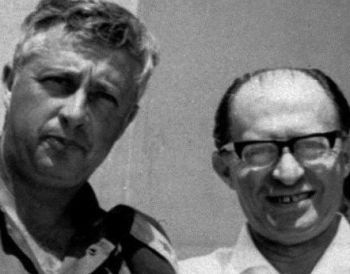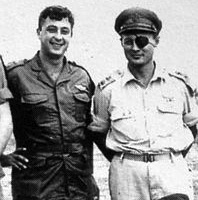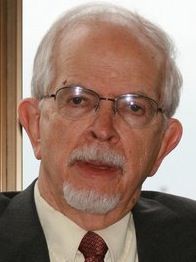
Publisher:
Bonnie King
CONTACT:
Newsroom@Salem-news.com
Advertising:
Adsales@Salem-news.com

~Truth~
~Justice~
~Peace~
TJP
Jan-14-2014 13:33

 TweetFollow @OregonNews
TweetFollow @OregonNews
Ariel Sharon Dies After Eight Years in a Coma
Dr. James M. Wall Salem-News.comDeprived of dignity, his body systems sustained by modern technology, Sharon lingered for eight years, largely forgotten by the world.
 AP photo of Sharon and Begin |
(CHICAGO) - Ariel Sharon died January 11, 2014, eight years and one week after he suffered a stroke January 4, 2006. At the time of his stroke, Sharon was the 11th Prime Minister of Israel. The stroke left him in a permanent, brain dead, vegetative state. It was not the final chapter of life a proud man could have wanted.
A medical blog described Sharon’s final years: ”With the help of modern medicine, his body soldiered on. His kidneys no longer worked, and he received dialysis to keep them operating. In 2013, he even underwent surgery to treat an infection related to his kidney failure”.
Deprived of dignity, his body systems sustained by modern technology, Sharon lingered for eight years, largely forgotten by the world. Ramifications of his legacy, however, remain very much alive in Israel. Sharon embodied and acted on the worst elements of intolerance, racism and greed a nation can embrace.
The impact of the path on which Sharon set Israel resulted in today’s self-imposed isolationism. Thanks to a the legacy of right wing leaders like Sharon, and Menachem Begin (shown together above in a 1967 photo) Israel has been unable to resist the impact of a boycott movement that has attacked Israel’s economy and undermined its world image.
As a demonstration of this isolation, no foreign leaders attended his final service, which was conducted Monday in front of the Knesset. The highest ranking world figure at the service was U.S. Vice President Joe Biden, a politician with an eye on 2016, who appeared as concerned about Israel’s close bond to the U.S. as he was about Sharon.
Former British Prime Minister Tony Blair was there, not as a public official, but as the staff director of the Quartet (the United Nations, the European Union, the United States and Russia), itself a lingering, dying effort to sustain and monitor peace efforts between Israel and the Palestine Authority.
It is a measure of how far Israel has fallen in world esteem that when the assassinated Israeli Prime Minister Yitzhak Rabin was buried in 1995, a sitting U.S. President and two former U.S. presidents were in attendance. Egypt was the only Arab state to send a low level representative to Sharon’s service. The last eight years have not been good for either Israel or a comatose Ariel Sharon. If you read or look beyond the main stream media, It is not hard to see why.
Max Blumenthal sums up Sharon’s legacy for The Nation:
- A central player in Israeli affairs since the state’s inception, Ariel Sharon molded history according to his own stark vision. He won consent for his plans through ruthlessness and guile, and resorted to force when he could not find any. An accused war criminal who presided over the killing of thousands of civilians, his foes referred to him as “The Bulldozer.” To those who revered him as a strong-armed protector and patron saint of the settlements, he was “The King of Israel.”
Months prior to his stroke, Sharon “stunned” the world by forcibly withdrawing 10,000 Israeli settlers (and their military protectors) from Gaza. “Stunned” is the word used by Israeli narrators and repeated endlessly by media sycophants. It paints Sharon as a strong leader willing to work for peace. The Gaza withdrawal was not stunning; it was a shrewd, calculating, strategic military move to end a Gaza occupation that was not benefiting Israel.
Eight years later, the “stunning” step has led to an open air prison, periodically attacked by the IDF in what might be correctly identified as a “stunning” silence by the rest of the world. The withdrawal was not magnanimous; it was a typical power play by Sharon which led to the situation today, writes Blumenthal, in which:
- Gaza suffers under a joint Israeli-Egyptian siege, while Israel shrugs off any responsibility for its inhabitants. Though Israel controls the entrances, exits, airspace and coast of Gaza, and effectively regulates the caloric intake of each resident of the coastal territory, the occupation is over as far as its government is concerned.
- Meanwhile, a few miles away from Gaza’s open air prison:
- Israeli settlements are firmly entrenched in the West Bank and encircle East Jerusalem, reducing Palestinian areas to the “pastrami sandwich” of non-contiguous bantustans that Sharon had originally envisioned. With the peace process effectively embalmed in political “formaldehyde,” right-wing elements have achieved unfettered dominance over the Jewish state’s key institutions.
Sharon’s contribution to the future of Israel and the Palestinians provides Blumenthal with a metaphorical image he could not resist::
- Now that Sharon’s unilateral vision appears to have been consolidated, Israel’s government must perpetually manage an occupation it has no intention of ending. It has no clear strategy to achieve international legitimacy and no endgame. Its direct line to Washington has become a life-support system for the status quo. Like Sharon, who spent his last years in a comatose state without any hope of regaining consciousness, Israel is only buying time.
History will not recall Sharon with favor. Mainstream media feels compelled to refer to his career as “controversial”, a term even Joe Biden felt he had to reference in his otherwise laudatory funeral remarks. “Controversial” is media code word for “we know there is bad stuff out there but you did not hear it here”.
Juan Cole gives body to “controversial” when in his Informed Comment blog, he offers “Top Ten Ways Ariel Sharon Ruined Israel and the Middle East”. Number six is probably Sharon’s darkest career hour:
- Sharon crafted the invasion of Lebanon in 1982. It was intended to allow him to put Christian allies of Israel in power in Lebanon. Likewise, he wanted to destroy the Palestine Liberation Organization, then headquartered in Beirut.
- The invasion, which had no basis in international law, resulted in the indiscriminate shelling of Beirut and the loss of some 20,000 Lebanese and Palestinian lives. . . During that war, Sharon bore responsibility for the massacre of women and children at the Sabra and Shatila refugee camps during the Israeli occupation. Remember that these Palestinians were refugees from Sharon and his fellow Israeli hawks in the 1948 war, when some 720,000 Palestinians were expelled from their homes and land and made penniless refugees.
- Now he had come after them and empowered far right wing Christian militiamen, who massacred them. Sharon hated the Palestinians because they refused to evaporate, and stood as a reproach to his ideology of Israelis’ birthright to Palestinian land.
Raja Shehadeh (right) a Palestinian lawyer, novelist and political activist who lives in Ramallah, continues the story in a posting he wrote for The New Yorker:
 |
- “In 1982, after the Israeli invasion of Lebanon and the massacre at Sabra and Shatila, the largest protest in the history of Israel came out against headed by the Chief Justice of Israel’s Supreme Court, Yitzhak Kahan, determined that Defense Minister Sharon was negligent, and should have foreseen that permitting Lebanese Phalangist forces to enter the Palestinian camps carried the potential for catastrophe. Sharon was forced to resign.
This could have been the end of his political career. It was not. Shehadeh continues:
- “The man did not have a social vision for his country; economics bored him. He must have known that he would only get a second chance when the drums of war began to beat again. It is not surprising, then, that when the Oslo Accords were concluded—promising peace at the end of an interim period—Sharon provocatively waged a fierce battle against the agreement.
- His return to power came after he deliberately walked with a large contingent of armed guards into the Dome of the Rock compound in September, 2000, helping to ignite the second Palestinian Intifada.”
 |
- In March, 2001, Sharon was elected prime minister, the position he held until he suffered his stroke in January, 2006, ending a long military/political journey which, except for the occasional downturn, like Sabra and Shatila, continued from early military success to the prime minister’s post.
- In 1955, he was photographed (at left) with Moshe Dayan, then the IDF Chief of Staff and later Israeli Defense Minister and Foreign Minister.
Avi Shlaim, (shown at right below) professor emeritus of international relations at St. Antony’s College, Oxford University, is the author of Israel and Palestine: Reappraisals, Revisions, Refutations and The Iron Wall. He remembers Sharon this way in The Guardian:
- “President George W Bush famously described Sharon as “a man of peace”. For the last 40 years the Arab-Israeli conflict has been my main research interest, and I have not come across a scintilla of evidence to support this view. Sharon was a man of war through and through, an Arab-hater, and a pugnacious proponent of the doctrine of permanent conflict. Following his rise to power Sharon therefore remained what he had always been – the champion of violent solutions.
 |
- The dominant preoccupation of Sharon’s premiership was the “war on terror” against militant Palestinian groups. No peace negotiations with the Palestinian Authority took place between 2001 and 2006, and Sharon regarded this as something to be proud of. To his way of thinking negotiations necessarily involve compromise, and he consequently avoided them like the plague. . . .
- His enduring legacy has been to empower and embolden some of the most racist, xenophobic, expansionist, and intransigent elements in Israel’s dysfunctional political system.”
Sharon’s legacy will long be a topic of “controversy”. The question remains, however, as to why Sharon was kept on life support for eight years and one week. That is a societal and finally, a theological, question, which every society needs to face:
Time‘s posting by Alice Park is appropriately entitled Life vs. Living: Lessons from Sharon’s Last Years in a Coma. It provides background for that discussion:
- Traditionally, [in Israel] the concept of brain death didn’t exist, as death is considered the simultaneous shutting down of the body’s primary functions—from the pumping of blood to breathing and thinking. But with the introduction of technology to keep some body systems working—such as the heart and lungs—the need to redefine death became critical.
- And the idea of brain death—similar to a death caused by a heart that stopped beating or lungs that stopped breathing—seeped into the culture and legal system as Sharon hung on. In 2009, the Israeli government passed the Brain-Respiratory Death Law that addressed religious concerns about defining the line between life and death and the latest medical knowledge.
- It required that several brain scans and other techniques would have to verify an irreversible lack of brain activity in order to declare the patient brain dead. The law was an attempt to encourage organ donation from patients whose bodies were otherwise healthy, but whose brains had all be ceased to function.
- Even with the new medical criteria, however, some Israelis found it hard to relinquish religious concepts of life and death, and continued to find any life, even in a vegetative state, worth preserving.
http://wallwritings.me/2014/01/14/sharon-dies-after-eight-years-in-a-coma/
Please visit James Wall's Website, Wall Writings
 Journalism was Jim Wall’s undergraduate college major at Emory University, Atlanta, Georgia. He has earned two MA degrees, one from Emory, and one from the University of Chicago, both in religion. An ordained United Methodist clergy person; he and his wife, Mary Eleanor, are the parents of three sons, and the grandparents of four grandchildren. They live in Elmhurst, Illinois.
Journalism was Jim Wall’s undergraduate college major at Emory University, Atlanta, Georgia. He has earned two MA degrees, one from Emory, and one from the University of Chicago, both in religion. An ordained United Methodist clergy person; he and his wife, Mary Eleanor, are the parents of three sons, and the grandparents of four grandchildren. They live in Elmhurst, Illinois.
Jim served for two years on active duty in the US Air Force, and three additional years in the USAF (inactive) reserve. While serving with the Alaskan Command, he reached the rank of first lieutenant. He has worked as a sports writer for both the Atlanta Journal and Constitution, was editor of the United Methodist magazine, Christian Advocate for ten years, and editor and publisher of the Christian Century magazine for 27 years, starting in 1972. Time magazine wrote about the new editor, who arrived at the Christian Century determined to turn the magazine into a hard-hitting news publication. The inspiration for Wall Writings comes from that mindset and from many other sources that have influenced Jim’s writings over the years, including politics, cinema, media, American culture, and the political struggles in the Middle East. Jim has made more than 20 trips to that region as a journalist, during which he covered such events as Anwar Sadat’s 1977 trip to Jerusalem, and the 2006 Palestinian legislative election. He has interviewed, and written about, journalists, religious leaders, political leaders and private citizens in the region. You can write to Jim Wall at jameswall8@gmail.com. Visit Jim's Website: Wall Writings
 |
 |
 |
Articles for January 13, 2014 | Articles for January 14, 2014 | Articles for January 15, 2014


Salem-News.com:


Quick Links
DINING
Willamette UniversityGoudy Commons Cafe
Dine on the Queen
Willamette Queen Sternwheeler
MUST SEE SALEM
Oregon Capitol ToursCapitol History Gateway
Willamette River Ride
Willamette Queen Sternwheeler
Historic Home Tours:
Deepwood Museum
The Bush House
Gaiety Hollow Garden
AUCTIONS - APPRAISALS
Auction Masters & AppraisalsCONSTRUCTION SERVICES
Roofing and ContractingSheridan, Ore.
ONLINE SHOPPING
Special Occasion DressesAdvertise with Salem-News
Contact:AdSales@Salem-News.com
Terms of Service | Privacy Policy
All comments and messages are approved by people and self promotional links or unacceptable comments are denied.
[Return to Top]
©2026 Salem-News.com. All opinions expressed in this article are those of the author and do not necessarily reflect those of Salem-News.com.